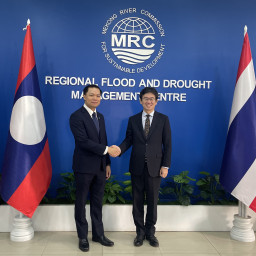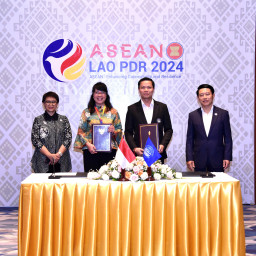3S Basins take another step towards shared long term trans-boundary vision
If you don’t know where you are going you will probably end up somewhere else.
Building a shared vision of what we want for the future is essential if we are to address current challenges, and manage our resources sustainably and equitably. This requires different stakeholders coming together to share their analysis of current trends, their aspirations for the future and to work together to identify strategies for action. With pressures on water resources intensifying the need for such action is all the greater.
This process that has begun under the ADB 3S Study (RETA 6367) in partnership with the MRC BDP will continue under a Regional Trans-boundary River Basin Meeting held in Buon Me Thuot City, Viet Nam. This meeting brings together people from all parts of society to further reflect on visions for the future, to analyse current development trends and to identify strategies for improved collaboration across the three countries.
This meeting will bring together over 130 local and central Government agencies, developers, research institutions and non-government organizations (NGO's) who have gathered for a 2 day meeting and field trip to discuss the strengthening of trans-boundary collaboration across these basins.
Ian Makin, Senior Water Resources Management Specialist with the Asian Development Bank (ADB), who along with the Mekong River Commission (MRC), jointly supported this initiative pointed out that, "This meeting fits perfectly with the ADB's approach to strengthening water resource management, in order to ensure that all people have access to enough safe water to meet their needs for their own wellbeing and development, while maintaining the integrity of freshwater ecosystems on which such development depends. This is essential for fulfilling ADB's commitment to reducing poverty through plans for inclusive and environmentally sustainable growth and the especially important regional integration of development plans".
"Engaging all stakeholders in the decision making process enables each to benefit from investments and new opportunities. Improving stakeholders' access to knowledge and involvement in planning will help ensure beneficial impacts reach the communities affected by decision about the use of water and other resources" he added.
The MRC says this meeting is one of a number planned, at a regional level, aimed at promoting stronger cooperation among the three countries and their stakeholders who share the 3S Basins. The 3S Basins are the largest tributary's and watersheds of the Mekong River Basin, with 193,000 in Cambodia, 222,000 in Lao PDR and over 3 million people in Viet Nam, sharing its resources - many of whom are from ethnic minorities and the poorest social groups.
"All the stakeholders including local communities of the 3S basins need to be involved in developing a Vision of an adaptable and sustainable integrated water resource use approach that will see positive long term growth out to 2040 and beyond. This meeting marks an important step forward in promoting information sharing, dialogue and cooperation between the countries and stakeholders to address these challenge of ensuring effective water resources management," said Mr.Jeremy Bird, CEO of the MRC Secretariat at the meeting.
"Supporting stakeholders to develop a vision of the 3S Basin that enables social equity across nations, promotes the environment and provides for an economically sustainable and safe future, is the aim that the MRC has for this region," said Mr. Bird.
The MRC says water resource development, done sustainably, has the potential to meet the accelerating population and economic growth demands of the region. The rapid changing needs of society and varied approaches to development have witnessed altering forest land use, into agricultural projects, industrial crops and also for mining schemes. There has been an expansion of hydropower use from four dams with an installed capacity of 883 MW in the 1990's, to the present with proposals for 41 dams with an installed capacity eight times larger (at 7,000 MW). Water resources in the 3S are already under considerable pressure and this is likely to increase with growing demand on water resources, and with the emerging threat of climate change. This meeting provides space for stakeholders to analyse the trends and to consider implications for long-term sustainable development.
The 3S Basin is an integral part of the Lower Mekong fish migration system with most migratory species moving from the Tonle Sap and Mekong mainstream to spawn and grow. The three rivers contribute about 20% of the water flow and 15-40% of sediment to the Mekong system and as such are particularly significant to for Tonle Sap and the Mekong Delta.
"The 3S Basin plays a crucial part in the Mekong cooperation. Choosing any development options must take into account the high dependency of many poor ethnic people on the water and natural resources for their food and livelihoods. Good cooperation between two countries sharing a tributary of the Mekong River is also significant for the multi-lateral cooperation among the four MRC Member Countries and the six Riparian countries in the Mekong River Basin," said Mr. Bird.
The MRC says its analysis helps provide all three countries and stakeholders with a comprehensive picture of 3S Basin development opportunities and risks in a broader context of other development trends in the Mekong River Basin. Highlighting potential implications of development trends in one country across the others sharing the 3S rivers and on the Lower Mekong Basin as a whole will help promote discussion on urgently needed trans-boundary collaboration among the three countries, their respective agencies, provinces and communities as well as all other stakeholders.
Recognised globally as a biodiversity hotspot, 20-30% of the 3S Basin is within national protected areas. The MRC says planned large scale developments in Cambodia, Lao PDR and Viet Nam provide opportunities to meet the energy requirements and economic growth but would also bring environmental and social concerns that need to be fully understood and taken into account in decision making. These concerns include, among others, hydropower dams trapping sediment, trans-boundary water quality impacts, soil erosion and social impacts on the vulnerable resource users.
-ends-
Languages
Download this press release in:
Notes to Editors
- Photos available on request
- Sekong, Sesan and Sepok River Basins.
With an approximate area of 78,650 km2, of which 33% lies in Cambodia, 29% in Lao PDR and 38% in Viet Nam, the 3S forms the largest and also the most complex trans-boundary system of the Mekong River. It is home to a rapidly growing population of about four million people, the majority of whom (more than three million) live in five provinces that spread in all the three river basins in Viet Nam. There are 193,000 people, living in six provinces in the Cambodian parts of the basin and 221,000 people in the Sekong river basin in Lao PDR. The 3S population consists of many ethnic groups, whose identities are across national boundaries and who are among the poorest groups in their countries. - The Asian Development Bank (ADB) is an international development finance institution whose mission is to help its developing member countries reduce poverty and improve the quality of life of their people. Under Strategy 2020, a long-term strategic framework adopted in 2008, ADB will follow three complementary strategic agendas: inclusive growth, environmentally sustainable growth, and regional integration. In pursuing its vision, ADB's main instruments comprise loans, technical assistance, grants, advice, and knowledge.
- The MRC is the intergovernmental body responsible for cooperation on the sustainable management of the Mekong Basin whose members include Cambodia, Lao PDR, Thailand and Viet Nam. In dealing with these challenges, it looks across all sectors including sustaining fisheries, identifying opportunities for agriculture, maintaining the freedom of navigation, flood management and preserving important ecosystems. Superimposed on these are the future effects of more extreme floods, prolonged drought and sea level rise associated with climate change. In providing its advice, the MRC aims to facilitate a broad range of dialogue among governments, the private sector and civil society on these challenges.
- The MRC Basin Development Plan Programme promotes the coordinated development and management of water and related resources, in order to maximise economic and social welfare in a balanced way without compromising the sustainability of vital ecosystems. This requires the preparation of information that informs discussion and decisions on achieving an acceptable balance between development of the basin and maintenance of its ability to sustain livelihoods and environmental values.
For More Information
Ms Tiffany Hacker, Interim Communication Advisor
Tel: +856 56120695 or +856 21 263 263 Ext. 4703
Email: damian@mrcmekong.org
Mr Khy Lim, Communication Officer
Tel: +856 20 5622 8131
Email: khy@mrcmekong.org




